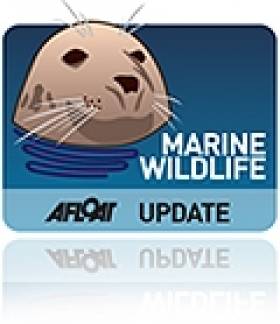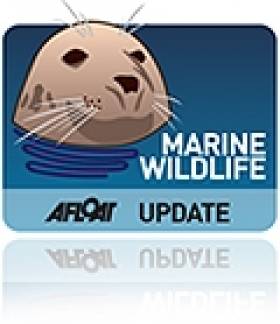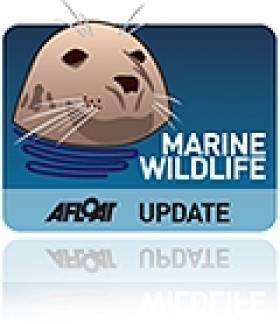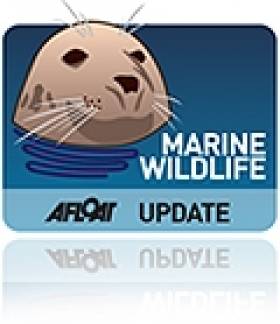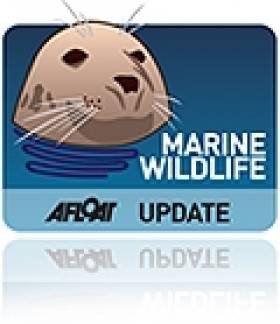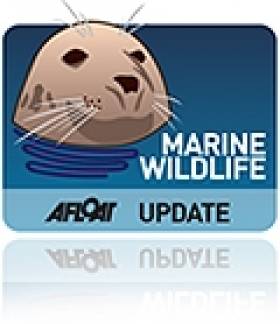Displaying items by tag: Humpback Whale
Whale Watchers Rejoice As Boomerang Comes Back With A Humpback Mate
#MarineWildlife - The humpback whale known as Boomerang is back – and this time he may have found a mate, according to The Irish Times.
Last spotted almost exactly a year ago off the south coast at the Cork-Waterford border, as previously reported on Afloat.ie, the humpback formally known as HBIRL3 has been spotted by the Irish Whale and Dolphin Group's Andrew Malcolm in recent days in the same location.
But this time he wasn't alone, as another humpback – HBIRL6, a female who last visited Waterford in 2008, and was previously seen with a juvenile off Co Kerry – was keeping him good company. The irish Times has more on the story HERE.
In other cetacean news, the large whale carcass that washed up on Portstewart Strand earlier this month is believed to have died of natural causes.
Originally confirmed as the remains of an adult female sei whale, the 43-foot behemoth has now been identified as a fin whale, most likely a juvenile, as the Belfast Telegraph reports.
Though the cause of death is "inconclusive", it is thought that due to its peeling skin, thin blubber layer and reduced muscle mass, the whale was already dead for days and decomposing before it washed up on the North Coast beach on 4 October.
Fin whales are the second largest mammal in the world's oceans behind only the blue whale.
Air Corps Crew Spot 'Humpback' or 'Blue' Whales off Ireland's West Coast
The sighting, initially believed to be Humpbacks, may in fact be Blue Whales and the Irish Whale and Dolphin Group has been asked to confirm the species photographed by the Air Corps off the West coast at the weekend.
To date 24 species of the world's whales and dolphins have been recorded in Irish waters.
Comment on Twitter and facebook as follows:
@AfloatMagazine Looks like Blue whales, what a find! Well done 101 squadron.
— Baltimore Sea Safari (@BaltimoreSafari) September 13, 2015
It looks like Irish Air Corps 101 squadron found Blue Whales off the west coast of Ireland over the weekend. Photos @IrishAirCorps Twitter account.
Posted by Baltimore Whale and Dolphin Watch on Monday, 14 September 2015
@AfloatMagazine Blue certainly
— Baltimore WhaleWatch (@BaltimoreWhale) September 14, 2015#MarineWildlife - A paddleboarder "still can't believe" the moment when a humpback whale surfaced right under his board off West Cork earlier this week.
As the Irish Examiner reports, Jason Coniry was out for a paddle with fellow boarders off Inchydoney beach on Wednesday evening (17 June) when the ocean giant appeared suddenly before him.
Luckily for the Corkman – who took the 'special endeavour' award in the Ocean to City An Rás Mór last month for being the first ever stand-up paddle board entrant – the whale was nothing more than curious about him and his fellow humans on the surface.
And Coniry has the presence of mind – and the available tech – to record the incredible marine wildlife experience on video to share with the world.
“Instinct guides us as to when it’s unsafe," he said of the respectful close encounter. "The whale’s movements are very intentional and accurate. If it did not want us near it, we would definitely have known.”
The humpback visitor was certainly in safer company than fellow whales in the Antarctic, where Japan is expected to resume whale hunts by the end of the year – despite the International Whaling Commission not being satisfied of the need to hunt for research purposes.
The Irish Examiner has more on that story HERE.
#MarineWildlife - A humpback whale new to Irish waters has been confirmed by the Irish Whale and Dolphin Group (IWDG).
Photos of the humpback's fluke and dorsal fin captured by Nick Massett off Clogher and Sybil Heads in West Kerry at the weekend were examined by the IWDG's catalogue experts who have determined that the whale is a new arrival - and one with a fluke colouring that's rarely seen in Irish waters.
Details have since been sent to Allied Whale in the US state of Maine - which curates the North Atlantic humpback whale catalogue - to see if a match can be made among its database of more than 7,000 fluke images.
Meanwhile, Wildlife Extra reports that sailors in the Irish Sea are urged to keep a lookout for a large group of minke whales.
The group includes three juveniles and a calf previously spotted some 19 miles east of Ireland's Eye near Howth.
"Although sightings of Minke whale are to be expected in these waters, such a large group is a rare occurrence," said Danielle Gibas, sightings officer with the UK's Sea Watch Foundation, which is organising Britain's annual National Whale and Dolphin Watch this week till 3 August.
And in other cetacean news, scientists claim that dolphins call each other by name, calling back to the sound of their signature whistle but ignoring whistles that aren't theirs.
Herald.ie reports on the findings by marine scientists at the University of St Andrews, who studied a bottlenose dolphin group off the east coast of Scotland.
Using underwater speakers, they played synthesised versions of dolphin whistles they'd identified with particular dolphins to determine their reactions.
They were surprised to find that individuals called back after hearing their own 'name' but ignored others, whether they were for dolphins in the same group or strangers.
Isle of Man Sees First Humpback Whale In 3 Years
#MarineWildlife - BBC News reports that whale watchers in the Isle of Man have spotted the first humpback whale in the waters around the island since 2010.
Tom Felce of Manx Whale and Dolphin Watch confirmed the "very rare" sighting in the Irish Sea two miles south of Castletown last week.
It's an unusual location to spot one of these ocean giants, who are a regular sight off West Cork - but even cetacean spotters there have been surprised by changes in their activity as of late.
The west coasts of Ireland and Scotland lie in the humpback's usual migratory path from the cold polar waters where it feeds in summer to subtropical climes off North Africa where it breeds in winter.
BBC News has more on the story HERE.
#marinewildlife – A team of Irish scientists has just published the first information on the diet of fin and humpback whales in Ireland for one hundred years.
Until now, the only information on the diet of large baleen whales such as fin, humpback and minke whales in Irish waters, was gathered in 1913 by a Mr Burfield in Belmullet, Co Mayo where two whaling stations were operated by a Norwegian enterprise at the time. These whaling stations caught mostly fin whales as they migrated along the shelf edge close to Co. Mayo. Two new studies published in Marine Ecology Progress Series and Marine Mammal Science used stable isotopes and mixed modelling to reveal the diet of fin and humpback whales in Ireland.
Following regular sightings of fin, humpback and minke whales close to shore over the last 10-15 years there has been a resurgence of interest in whales in Irish waters. From June to February between Slea Head, Co. Kerry and Hook Head, Co. Wexford, fin and humpback whales appear to follow the seasonal movements of sprat and herring as they congregate inshore to spawn. The Irish Whale and Dolphin Group (IWDG), Galway-Mayo Institute of Technology and the Marine Institute collaborated on a project to determine what these whales were feeding on – essential information if we are to adopt a more sustainable 'ecosystem approach' to managing our fisheries. This ecosystem approach recognises that there are predators, other than humans in the marine ecosystem, which are entitled to marine resources and that these are an integral link in a complex food web which needs to be kept intact for the health of our oceans and for the benefit of our coastal communities.
Studying the diet of large whales is challenging. They cover vast distances and dive for up to 15 minutes at a time, and despite their huge size (fin whales up to 21m) they are difficult to follow and observe in the rough seas around Ireland. When they die and strand, it is difficult to obtain stomach samples before the carcase heats up with decay and quickly rots. At any rate, most of the stomach samples from dead whales are empty as these individuals tend to be sick. An alternative approach to investigating their diet was needed and this study used stable isotope analysis. The field of stable isotope analysis is rapidly becoming an essential tool for all scientists to trace food-webs and to follow ecosystem nutrient cycling in marine systems. In a novel way, this enables researchers infer information on their origins and dietary influences.
Skin samples were collected from fin and humpback whales using biopsy darts fired from a cross-bow. For the past decade, the IWDG Large Whale survey team has been conducting this field work during autumn and winter when the whales are close inshore in large numbers. They used local whale-watching boats or the IWDG rigid-hulled inflatable boat Muc Mhara to get close enough to the whales to dart them and photograph unique markings to help identify individual whales. This work was licensed by the National Parks and Wildlife Service. Chemical tracers, in this case stable carbon and nitrogen isotopes, in the skin of the whales were analysed. These same chemical signatures were measured in samples from sprat, herring and various krill species of different age classes, collected during annual fisheries surveys from the Marine Institute's R.V. Celtic Explorer. By matching the best fitting stable isotope signatures, the researchers were able to calculate what proportion of each prey species the whales were consuming.
The results showed that fin whales in Irish waters have a diet comprising 50% krill and 50% young sprat and herring. Throughout most of their range in European waters, fin whales feed almost exclusively on krill, so the Irish whales are unusual in that they rely heavily on small fish. Humpback whales seem to prefer sprat and herring when feeding in Irish waters and their diet comprised less than 30% krill. The research team also examined the long term diet of whales by analysing stable isotope values of baleen plates, which are flat sheets of fingernail-like tissue in the mouths of some large whales, used to filter food from the seawater. By using baleen plates stored in museums in Ireland and the UK the study examined changes in diet over the last 100 years. The main finding was that the long term diets of minke, fin and humpback whales are quite different from each other. This result was somewhat unexpected as these species are often seen feeding in close proximity to each other.
These results which have recently been published in the international science journals: Marine Mammal Science and Marine Ecology Progress Series, arise from a three year PhD project at the Galway-Mayo Institute of Technology (GMIT) and funded by the Irish Research Council.
Dr Conor Ryan said," We now have clear evidence that sprat and herring are important species supporting whales in Irish waters, and we must manage our fisheries with this in mind. We are very worried that sprat is being fished with an open quota, despite a huge gap in our knowledge about the life history of this important species in the Celtic Sea".
Dr Simon Berrow, lecturer in Marine Science at Galway-Mayo Institute of Technology (GMIT), Executive Officer of the IWDG, and member of the Celtic Sea Herring Management Advisory Committee added, "This data will be incorporated into the new Environmental Management Plan commissioned by the Celtic Sea Herring Management Advisory Committee which is essential for the proper management of these fisheries and ensuring this fishery is compliant with Marine stewardship Council requirements. Whale-watching is growing in Ireland and has the potential to expand much more if we manage these fish stocks for both fishers and whales and dolphins, which will bring further benefits to coastal communities".
Dr Brendan McHugh a chemist at the Marine Environment and Food Safety Services in the Marine Institute said, "Collaborative studies like this one between biologists and chemists are key to developing a greater understanding of ecosystem linkages and their impacts."
Humpback Surprises West Cork Over St Patrick's Weekend
#MarineWildlife - A juvenile humpback whale sighting off West Cork provided a St Patrick's weekend surprise for cetacean watchers.
Irish Whale and Dolphin Group (IWDG) sightings co-ordinator Pádraig Whooley writes on the discovery made off the Stags on the afternoon of Monday 18 March, which was verified by IWDG members Simon Duggan, Youen Yacob and Robbie Murphy.
Photo ID images captured at the scene allowed experts to confirm the whale is a newcomer to Irish waters, bringing the known total to 22 and continuing a growing trend.
Whooley also notes the unusual nature of the sighting, coming some months after the busy humpback whale activity in the area previously reported on Afloat.ie.
Those whales weren't seen again after that flurry of breaching and bubble-netting off Baltimore - presumably because being an older group, they were drawn south by their migratory instinct to the tropical feeding grounds.
In contrast, this likely juvenile - named Baltimore - may have opted to winter in higher latitudes to avoid competition with bigger counterparts, something that a group of humpbacks in the Norwegian fjords have also chosen to do this year.
The IWDG has more on the story HERE.
#MARINE WILDLIFE - Another humpback whale sighting off West Cork has been confirmed by the Irish Whale and Dolphin Group (IWDG) - and it could be a new arrival to these shores.
The humpback was encountered some seven miles southeast of Galley Head near Clonakilty Bay on Wednesday 16 May by local whale watch operator Colin Barnes.
A tell-tale series of three blows and a tail fluke were enough for Barnes to confirm the species, but unfortunately its identity could not be confirmed, which means it could be a newcomer to Irish waters or one of two humpbacks sighted in the same area in earl April, as previously reported on Afloat.ie.
"If it is a new animal, this will bring to 21 the number of recognisable humpbacks recorded to date in Irish waters," said IWDG sightings co-ordinator Pádraig Whooley, who noted with interest that while the group is concluding its field work in the seasonal feeding grounds around Cape Verde, there are "also humpbacks present at higher latitude feeding grounds".
Whooley commented at the time of the April sightings: "Why these two young humpbacks are here during spring, when years of data shows them to be absent in these months, is a mystery."
The IWDG has more on the story HERE.
Humpback Whale Spotted Off Achill
#MARINE WILDLIFE - The Irish Whale and Dolphin Group has confirmed the sighting of a humpback whale off Achill Island in Co Mayo last weekend.
Surfers off Keel Beach were credited with the discovery, after spotting a large whale of 30-60ft breaking the surface multiple times, lifting its tail fluke vertically.
The sighting is only the fifth validated record of a humpback whale off the coastal area from Galway to Donegal.
"It remains something of a mystery as to why sightings of this species remain such relatively rare events along our west and northwest compared to our south and southwest coasts," says IWDG sightings co-ordinator Pádraig Whooley.
"This latest sighting is a timely reminder that species such as humpbacks can and do turn up in places that are well outside what we perceive to be the known 'hotspots'."
Humpback whales tend to feed in inshore waters, which should make them increasingly easier for the public to spot from the shore, he added.
The IWDG has more on the story HERE.
First Humpback Whale Sighting of 2012 Is a Newcomer
#MARINE WILDLIFE - Ireland's first humpback whale of the year has been spotted off the Wexford coast.
The sighting was made yesterday by whale-watchers among a pod of fin whales some three miles south of Hook Head, according to TheJournal.ie.
The Irish Whale and Dolphin Group (IWDG) has also confirmed that the humpback is a new sighting in Irish waters, and has been designated the reference HBIRL18.
RTÉ News has images of the humpback whale HERE.


























